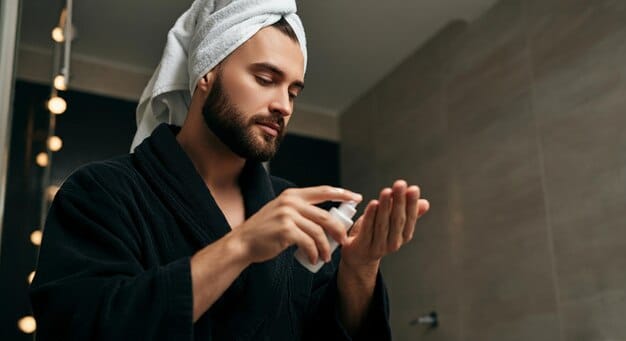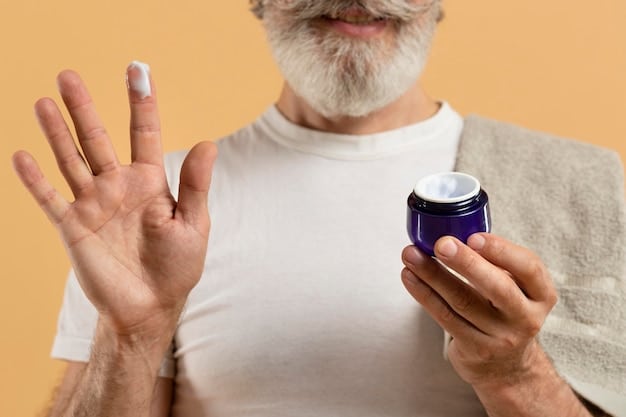Retinol for Men: Your Complete Guide to Starting Strong

Navigating the world of Retinol for men involves understanding how to effectively incorporate it into a skincare routine and determining the right percentage to use based on individual skin type and concerns, ensuring optimal results and minimizing irritation.
For many men, the concept of a dedicated skincare routine might seem complex, but integrating potent ingredients like retinol can dramatically transform skin health. Retinol for men: How to Start and What Percentage is Right for Your Skin Type is a frequently asked question, reflecting a growing masculine interest in effective dermatological solutions. This guide aims to demystify retinol, offering clear, actionable advice for men looking to enhance their complexion and combat signs of aging without unnecessary complications.
Understanding Retinol: More Than Just an Anti-Aging Cream
Retinol, a derivative of Vitamin A, is one of the most thoroughly researched and dermatologist-recommended ingredients in skincare. Its reputation as a powerhouse ingredient is well-earned, attributed to its remarkable ability to stimulate collagen production and accelerate cell turnover. For men, whose skin often faces unique challenges like irritation from shaving or increased sun exposure during outdoor activities, retinol can be particularly beneficial, addressing concerns from fine lines to rough texture and hyperpigmentation.
This active compound works at a cellular level, signaling skin cells to behave like younger, healthier cells. This process helps to smooth out wrinkles, minimize pores, and even out skin tone. Beyond its anti-aging benefits, retinol is also an effective tool for managing acne due to its ability to unclog pores and reduce inflammation. It’s a versatile ingredient that offers a comprehensive approach to skin health, making it a valuable addition to any man’s grooming regimen.
What Exactly is Retinol?
Retinol is a type of retinoid, which is a class of compounds derived from Vitamin A. When applied topically, it is converted into retinoic acid, the active form that interacts with skin cells. This conversion process is what makes retinol less irritating than prescription-strength retinoids, yet still highly effective.
- Cell Turnover: Retinol speeds up the natural exfoliation process of the skin, replacing older, duller cells with fresh, new ones.
- Collagen Production: It stimulates fibroblasts, the cells responsible for producing collagen, leading to firmer, plumper skin.
- Hyperpigmentation: By accelerating cell renewal, retinol helps to fade dark spots, sun spots, and post-inflammatory hyperpigmentation.
The Science Behind Its Efficacy
The true power of retinol lies in its molecular structure, which allows it to penetrate deeply into the skin’s layers. Once absorbed, it binds to specific receptors within skin cells, triggering a cascade of beneficial effects. This isn’t just a surface-level treatment; it’s a fundamental cellular reset that improves skin quality from within. The gradual conversion to retinoic acid allows the skin to adapt, making it suitable for consistent, long-term use.
Furthermore, ongoing research continues to unveil new benefits of retinol, including its potential role in strengthening the skin barrier and protecting against environmental damage. For men, whose skin might be more resilient but still susceptible to everyday stressors, this added layer of protection is invaluable. Integrating retinol means investing in a proactive strategy for maintaining youthful and healthy skin.
Preparing Your Skin for Retinol Integration
Before diving into retinol, it’s crucial to prepare your skin to minimize potential irritation and maximize benefits. Many men, accustomed to simpler routines, might overlook this preparatory phase. However, a well-prepared canvas will ensure a smoother transition and more impressive results. This initial period allows the skin barrier to strengthen and adjust, making it more receptive to the active ingredient.
The key to successful retinol integration lies in a minimalist yet effective approach. Overloading your skin with too many new products simultaneously can lead to sensitivity and breakouts. Focus on establishing a solid foundation with gentle cleansing and consistent moisturizing before adding retinol into the mix. This builds resilience and reduces the likelihood of adverse reactions.
Essential Pre-Retinol Skincare Steps
A gentle cleanser, a good moisturizer, and broad-spectrum sunscreen are your non-negotiables. These products form the backbone of any effective skincare routine, especially when introducing a potent ingredient like retinol. Think of it as building a strong foundation before adding the finishing touches.
- Gentle Cleansing: Use a mild, pH-balanced cleanser to remove impurities without stripping the skin’s natural oils. This helps maintain the skin barrier.
- Hydration is Key: An effective moisturizer will keep your skin supple and reduce dryness, which can often be a side effect of retinol use. Look for ingredients like hyaluronic acid or ceramides.
- Sun Protection: Retinol can make your skin more sensitive to the sun. Daily use of a broad-spectrum SPF 30+ sunscreen is non-negotiable, even on cloudy days.
Patch Testing and Gradual Introduction
Before applying retinol all over your face, perform a patch test on a small, inconspicuous area of skin, like behind your ear or on your neck. Observe the area for 24-48 hours for any signs of severe irritation, redness, or itching. This simple step can prevent widespread discomfort.
Once you’ve confirmed no adverse reactions, start with a low frequency. Apply retinol only once or twice a week for the first few weeks, preferably at night. Gradually increase the frequency as your skin adapts, moving to every other night, and then eventually nightly use if tolerated. This slow and steady approach is paramount to avoiding what’s often referred to as “retinol uglies” — a period of increased redness, peeling, and sensitivity. Patience is a virtue when it comes to retinol.
How to Start Using Retinol: A Step-by-Step Guide for Men
Beginning your retinol journey doesn’t have to be intimidating. By following a structured, step-by-step approach, men can seamlessly incorporate this powerful ingredient into their nightly routine, minimizing the chances of irritation and maximizing its benefits. Consistency and patience are the cornerstones of success, allowing your skin to gradually adapt and reveal its improved texture and appearance.
The sequence in which you apply your products matters significantly when using retinol. Applying it on clean, dry skin ensures optimal absorption, while following up with a moisturizer helps to mitigate any potential dryness or flakiness. This strategic layering is key to a comfortable and effective experience.
The Retinol Application Routine
Always apply retinol on clean, dry skin. After cleansing your face, pat it completely dry and wait a few minutes to ensure there’s no residual moisture, which can sometimes enhance irritation. A pea-sized amount is generally sufficient for the entire face and neck; more is not necessarily better.
Apply the retinol gently, spreading it evenly across your face, avoiding the immediate eye area, nostrils, and corners of the mouth, which are often more sensitive. Always follow up with a good moisturizer to lock in hydration and soothe the skin. Remember, retinol should be used as part of your nighttime routine, as it can degrade in sunlight and increase photosensitivity.
- Cleanse: Start with a gentle face wash to remove dirt and oil.
- Dry: Pat your skin entirely dry and wait 5-10 minutes to ensure it’s completely arid.
- Apply Retinol: Dispense a pea-sized amount and gently spread it over your face and neck.
- Moisturize: Follow with a hydrating moisturizer to combat dryness.
- Sunscreen (AM): Essential every morning, regardless of the weather.

Common Side Effects and How to Manage Them
When first starting retinol, it’s common to experience some mild side effects. These often include redness, flakiness, dryness, and a slight purging period where skin may temporarily break out more. These are typically signs that your skin is adapting and are often temporary.
To manage these effects, ensure you’re using a rich, barrier-repairing moisturizer. Consider the “sandwich method” – applying a thin layer of moisturizer before and after retinol. If irritation persists, reduce the frequency of application or consider a lower percentage product. Avoid using other harsh exfoliants like AHAs/BHAs or physical scrubs on nights you use retinol, as this can exacerbate sensitivity. Patience is key; most skin types adjust within a few weeks to a couple of months.
Choosing the Right Retinol Percentage for Your Skin Type
Selecting the appropriate retinol percentage is paramount to a successful integration into your skincare regimen. It’s not a one-size-fits-all scenario; what works for one man might be too potent or too mild for another. Understanding your skin type and its inherent sensitivities is the compass that guides this crucial decision. Starting with a lower concentration and gradually increasing it is a universally recommended strategy, ensuring your skin has ample time to acclimate without overwhelming it.
Factors such as your skin’s resilience, its history with active ingredients, and specific concerns like acne or aging all play a role in determining your ideal starting point and progression. A careful assessment before purchasing will save you from potential irritation and ensure a more comfortable and effective experience.
Retinol Percentages Explained
Retinol products come in various concentrations, typically ranging from 0.01% to 1.0%. Over-the-counter strengths usually fall between 0.25% and 1%, while prescription-strength retinoids can be significantly higher. It’s important to note that a higher percentage doesn’t always equate to better results, especially when starting out.
Lower concentrations are excellent for beginners or those with sensitive skin, providing benefits with minimal irritation. As your skin builds tolerance, you can gradually increase the percentage for more pronounced effects. The key is to find the lowest effective dose for your skin.
For Sensitive and Dry Skin Types: Start Low (0.01% – 0.03%)
If your skin is prone to redness, flakiness, or feels tight easily, beginning with a very gentle retinol is advisable. Concentrations in the 0.01% to 0.03% range are ideal. These lower percentages still deliver significant benefits related to cell turnover and collagen stimulation but with a significantly reduced risk of irritation. Often, these formulations are buffered with hydrating ingredients to further minimize dryness.
Think of it as training for a marathon; you wouldn’t start with a full marathon, but rather with short, easy runs. The same principle applies to sensitive skin and retinol.
For Normal and Combination Skin Types: Moderate Start (0.05% – 0.25%)
Men with normal or combination skin, who may experience occasional oiliness in the T-zone but no consistent dryness or sensitivity, can often start with a slightly higher percentage, typically in the 0.05% to 0.25% range. These concentrations offer a good balance of efficacy and manageability, allowing for noticeable improvements in skin texture and tone without excessive side effects.
This range is a sweet spot for many, providing a noticeable impact on fine lines, uneven texture, and minor blemishes. Always remember to monitor your skin’s reaction closely and adjust accordingly.
For Oily and Resilient Skin Types: Higher Entry (0.3% – 0.5%)
If your skin type is oily, less prone to sensitivity, and perhaps already accustomed to active ingredients, you might be able to start with a retinol concentration of 0.3% or even 0.5%. These higher percentages can tackle more pronounced signs of aging, stubborn acne, and significant textural irregularities more aggressively.
However, even with resilient skin, the principle of gradual introduction still applies. Even if your skin handles strong products well, introducing retinol slowly will help prevent a sudden shock to the system. Always be prepared to scale back if unexpected irritation occurs.
Beyond Percentage: Other Factors Influencing Retinol Efficacy and Tolerance
While the percentage of retinol is a crucial consideration, it’s not the only factor that dictates how effective or irritating a product might be. The formulation of the retinol product itself, along with your overall skincare routine, plays a significant role in its efficacy and how well your skin tolerates it. Understanding these nuances can help men select products that are best suited to their individual needs and minimize potential downsides.
For example, the vehicle in which retinol is delivered (cream, serum, oil) can impact its absorption and potential for irritation. Additionally, other active ingredients in your routine, or even the time of year, can influence your skin’s response. A holistic view, moving beyond just the percentage, leads to a more nuanced and successful retinol journey.
Formulation Matters: Serums, Creams, and Oils
Retinol is available in a variety of formulations, each with its own characteristics regarding absorption and potential for irritation.
- Serums: Often lightweight and fast-absorbing, serums are good for delivering retinol deeply into the skin. They might be more potent.
- Creams: Generally thicker and more hydrating, retinol creams are often preferred by those with dry or sensitive skin as they provide a buffering effect.
- Oils: Retinol in oil formulations can also be very gentle, as the oil base helps to nourish and protect the skin barrier while delivering the active ingredient.
The choice of formulation can significantly impact how well your skin tolerates retinol. For beginners, a cream or oil formulation might be more forgiving, while those with more experience might prefer the direct potency of a serum.

Supporting Ingredients and Their Role
Many retinol products are formulated with complementary ingredients that can enhance efficacy and reduce side effects. Look for products that combine retinol with:
- Hyaluronic Acid: A powerful humectant that draws moisture into the skin, combating dryness.
- Ceramides: Lipids that help to repair and strengthen the skin barrier, reducing irritation.
- Niacinamide (Vitamin B3): Known for its anti-inflammatory properties, it can calm redness and improve skin resilience.
- Peptides: Can work synergistically with retinol to boost collagen production.
These supporting ingredients are not just fillers; they are crucial components that make a retinol product more user-friendly and effective, especially for sensitive skin types. They help to maintain skin hydration and reduce the often-unwanted side effects of initial retinol use.
Advanced Tips for Men Using Retinol
Once your skin has acclimated to regular retinol use, there are several advanced strategies men can employ to optimize their results and address specific skin concerns more effectively. These tips move beyond the initial integration phase, focusing on long-term maintenance and targeted improvements. From refining application techniques to combining ingredients judiciously, these insights can elevate your skincare game.
The journey with retinol is continuous; as your skin evolves, so too should your approach. Whether it’s tackling persistent pigmentation or enhancing overall skin radiance, strategic adjustments to your routine can unlock retinol’s full potential.
Combining Retinol with Other Actives
While it’s crucial to avoid overdoing it, certain skincare ingredients can be carefully paired with retinol to achieve enhanced results. The key is to integrate them strategically and not all at once, especially if you have sensitive skin.
Consider using Vitamin C in your morning routine and retinol at night. Vitamin C is a powerful antioxidant that protects against environmental damage and brightens skin, perfectly complementing retinol’s restorative nighttime work. Similarly, gentle hydrating acids like Polyhydroxy Acids (PHAs) can be used on alternating nights for mild exfoliation without overwhelming the skin. Always introduce one new active at a time to gauge your skin’s reaction. It’s generally best to avoid combining retinol with strong AHAs (like glycolic acid) or BHAs (like salicylic acid) simultaneously, as this can lead to excessive irritation.
Addressing Specific Male Skin Concerns with Retinol
Men often face particular skin challenges that retinol is well-equipped to address.
- Post-Shave Irritation and Bumps: Retinol’s ability to unclog pores and reduce inflammation can help minimize ingrown hairs and razor bumps. Integrate it carefully, avoiding application immediately after shaving to prevent excessive stinging.
- Sun Damage: Many men spend more time outdoors, leading to sun spots and uneven pigmentation. Retinol effectively fades these signs of sun damage and improves overall skin clarity.
- Rough Skin Texture: Retinol promotes smoother skin texture by encouraging rapid cell turnover, which is beneficial for the thicker or often rougher texture of male skin.
- Deep Wrinkles & Fine Lines: Due to its collagen-stimulating properties, retinol is highly effective in reducing the appearance of both fine lines and deeper wrinkles, especially around the eyes and forehead.
Consistency is key here. Regular, long-term use of retinol will yield the most significant improvements for these common male skin concerns.
Maintaining Long-Term Retinol Results for Men
Achieving desired skin improvements with retinol is commendable, but the true objective is to maintain these results over the long haul. This requires a commitment to consistency, continuous care, and a willingness to adapt your routine as your skin’s needs evolve. For men, integrating retinol into a lifelong skincare habit can ensure sustained anti-aging benefits and overall skin health.
The journey with retinol is not a sprint but a marathon. Proper maintenance involves more than just daily application; it encompasses protecting your skin, understanding its evolving challenges, and providing it with the nourishment it needs to thrive.
Consistency and Patience: The Unsung Heroes
Perhaps the most crucial aspect of long-term retinol success is unwavering consistency. Skipping days or weeks will hinder progress and prolong the adaptation phase. Regular, nightly use, even if starting with a lower frequency, ensures your skin continuously receives the signals needed for cellular repair and renewal.
Patience is equally vital. Visible improvements from retinol typically take weeks, often months, to fully manifest. Fine lines might diminish within 8-12 weeks, while hyperpigmentation and significant textural changes could take 6 months to a year. Do not get discouraged by the initial purging or slow progress; the cumulative effects are profound and lasting. Think of it as an investment in your skin’s future health and appearance.
Lifestyle Factors Supporting Retinol Efficacy
The benefits of retinol can be significantly amplified by a healthy lifestyle. Skincare is not just about what you put on your face; it’s also about how you live your life.
- Sun Protection: Reiterating its importance, daily sunscreen is paramount. UV radiation can undo all of retinol’s hard work, causing new damage and preventing full benefits.
- Balanced Diet: A diet rich in antioxidants (fruits, vegetables), healthy fats (omega-3s), and sufficient protein supports skin health from within. Hydration through water intake is also crucial.
- Adequate Sleep: Skin cells perform much of their repair and regeneration overnight. Sufficient sleep allows retinol to work more effectively.
- Stress Management: Chronic stress can trigger inflammation and skin issues. Managing stress through exercise, meditation, or hobbies benefits overall skin health.
- Hydration: Internally and externally, keeping your skin well-hydrated helps manage any dryness associated with retinol and maintains a healthy barrier function.
By adopting these lifestyle habits, men can create an optimal environment for retinol to perform its best, leading to healthier, more resilient, and youthful-looking skin for years to come.
| Key Point | Brief Description |
|---|---|
| 🚀 Starting Retinol | Begin with low concentrations (0.01%-0.03%) and apply gradually to allow skin adaptation, typically 1-2 times per week. |
| 🎯 Percentage & Skin Type | Sensitive: 0.01-0.03%; Normal/Combo: 0.05-0.25%; Oily/Resilient: 0.3-0.5%. Adjust based on skin response. |
| 🧴 Application & Routine | Use pea-sized amount on dry, cleansed skin at night, followed by moisturizer. Always use SPF 30+ daily. |
| 🚫 Side Effects & Care | Expect mild redness/dryness. Manage with hydration, gentle cleansers, and reducing frequency if needed. Avoid other strong actives initially. |
Frequently Asked Questions About Retinol for Men
Yes, retinol is highly effective for both acne and razor bumps. It works by unclogging pores, which reduces breakouts, and by promoting healthy skin cell turnover, which helps prevent ingrown hairs. Consistent use can lead to significantly smoother skin, especially for those prone to irritation after shaving.
Initial results, such as reduced oiliness or improved texture, may be noticed within 4-6 weeks. However, significant improvements in fine lines, wrinkles, and hyperpigmentation typically take 3-6 months of consistent use. Patience is key, as the skin needs time to adapt and regenerate for visible transformation.
Over-the-counter retinol products can be highly effective, especially for beginners, with percentages usually up to 0.5% or 1%. Stronger retinoids like tretinoin (pure retinoic acid) generally require a prescription from a dermatologist, as they are more potent and have a higher risk of irritation.
When starting, it’s best to use retinol 1-2 times a week to allow your skin to acclimate. As tolerance builds, you can gradually increase frequency to every other night, and eventually, every night if your skin tolerates it well. Listen to your skin and adjust accordingly to avoid irritation.
If significant irritation occurs, pause retinol use for a few days until your skin recovers. Then, reintroduce it at a lower frequency (e.g., once a week) or switch to a lower percentage product. Ensure you’re moisturizing generously and using a gentle cleanser. Always apply sunscreen diligently.
Conclusion
Ultimately, incorporating retinol into a man’s skincare routine is a strategic move towards achieving healthier, more youthful-looking skin. By understanding the science behind retinol, starting with appropriate percentages, and adhering to a gentle, consistent application method, men can effectively minimize common skin concerns and combat the signs of aging. The journey requires patience and attention to your skin’s unique needs, but the long-term benefits of improved texture, reduced fine lines, and a clearer complexion make it a worthwhile investment in your skin’s future.





